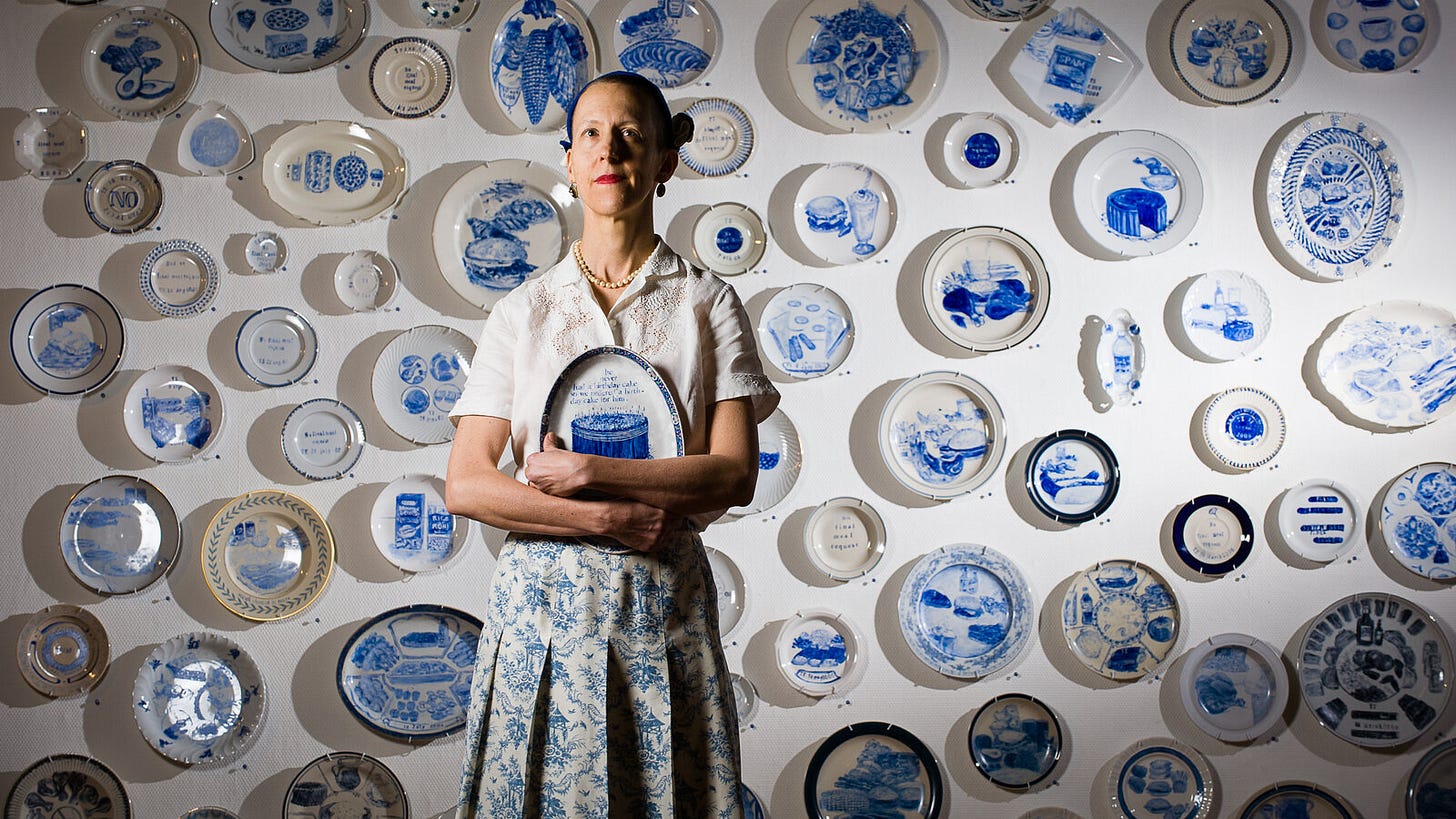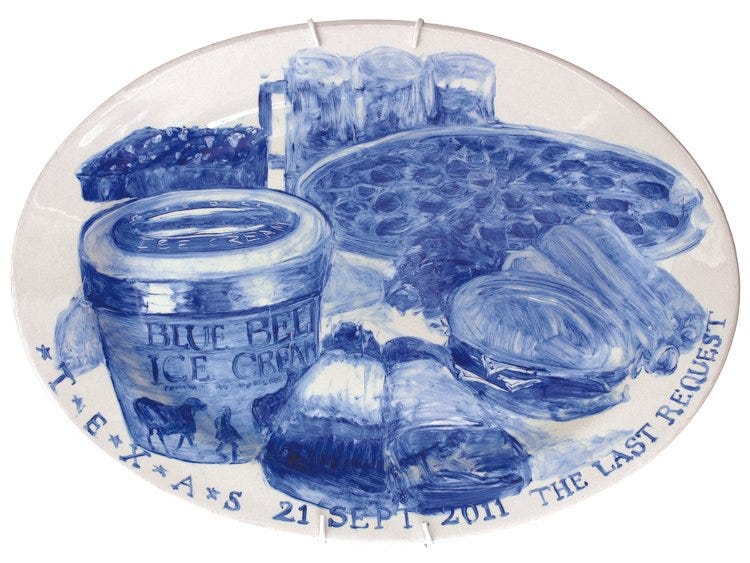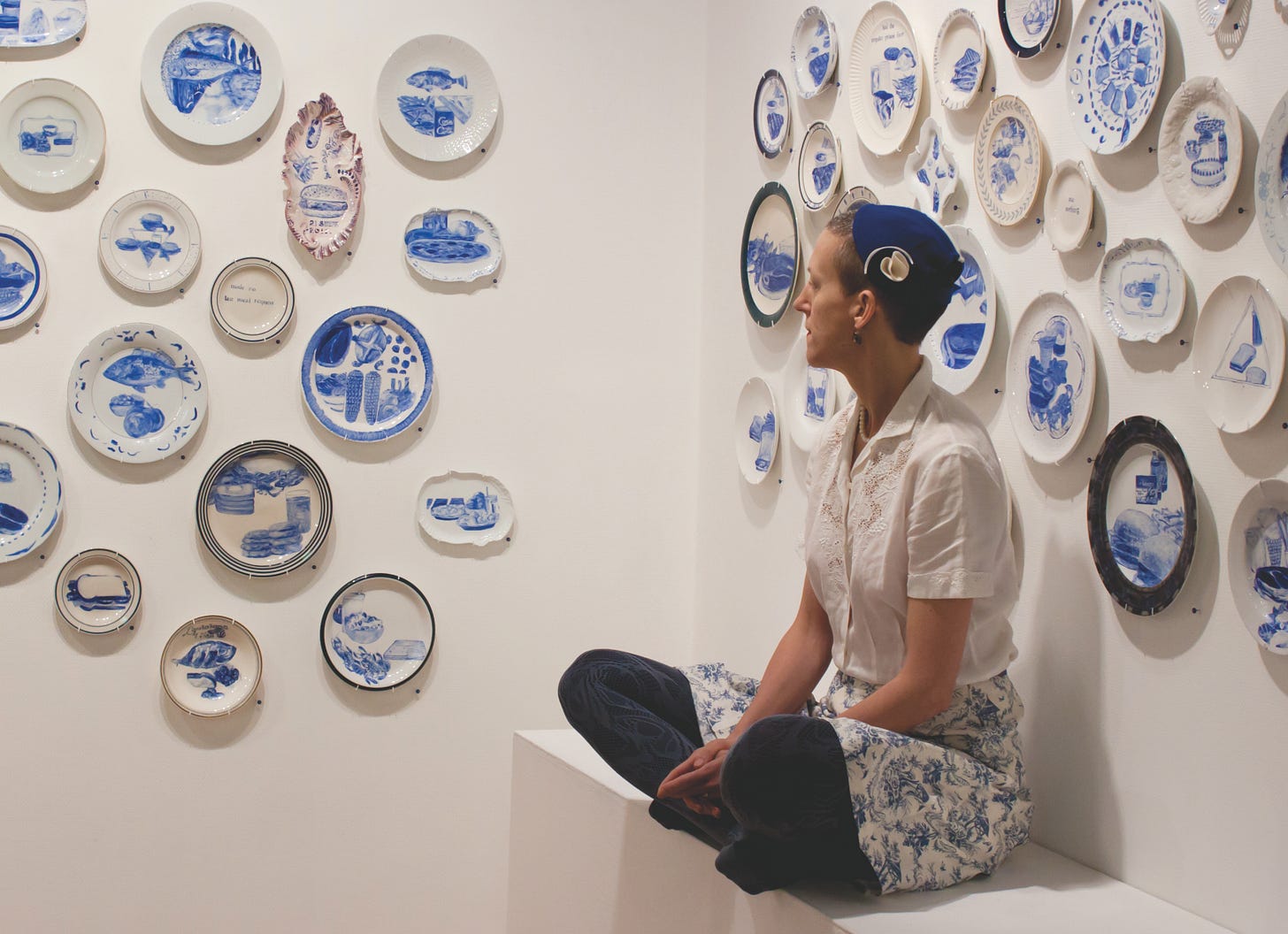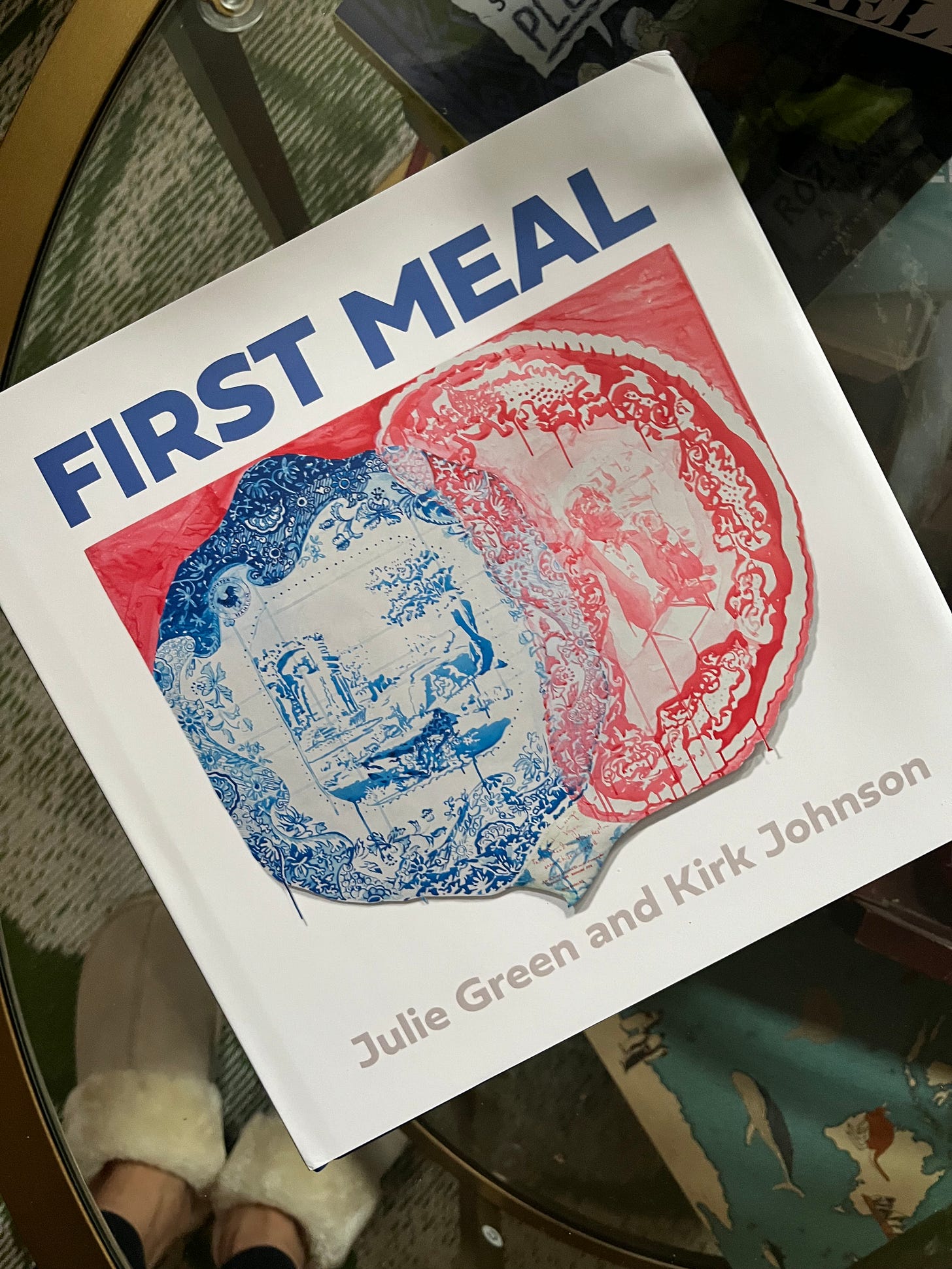Last Suppers and First Meals.
The legacy of Julie Green, who used food to try to eradicate capital punishment and frame the many flaws of our criminal justice system.
Friends,
This is a bit of a long story, but it’s a meaningful one, and I hope, if you have some time on the train, waiting in line, while you lie awake at night with insomnia, that you’ll take a moment to read it. It’s about an artist named Julie Green, her love of food, and her life's work to use her art—and food—to eradicate capital punishment and frame the many flaws of our criminal justice system. Here we go.
I met Julie in 2018, when I wrote a story about her for Eater that was probably the most meaningful piece of writing I’d ever put to digital paper.
As some of you may know, before embarking on my illustrious career as a food writer, I was a lawyer. I went to Brooklyn Law School and spent a lot of my time working on capital cases through a Death Penalty Appeals Clinic I did with Professor Ursula Bentele, where we represented those condemned to be killed by some “humane” method (no violations of the 8th amendment here!) on death row.
While in the clinic, I learned a tremendous amount about each defendant and their particular background (mostly black men from under-resourced communities), the case law, and the minutiae of legal process that could keep someone most probably innocent behind bars for decades.
But it was in digging into the bigger picture of the gears of the death penalty in this country that I really learned the most: how biased capital punishment is, and how race plays such an outsized role in convictions; how much more expensive it is to kill than to imprison for life; how a society that claims to want to preserve life, and therefore abolish abortion, can be so happy to take it, particularly when the life has brown or black skin. It should come as no surprise that I left law school rather disgusted with the criminal justice system.
Fast forward twenty five years, and I was at home reading The New York Times when I came upon an article about Julie Green’s Last Supper project. If you’ve heard of it, you know that Julie used plates to paint the intimate details of last meal eaten by a man or woman whose life would, just moments later, be snuffed out by our government. I knew I needed to meet her. I reached out to Julie through an email on her website and she responded. We set up a time to chat, and I began to learn more about her life.
Julie was raised in a conservative Christian family who were actually in favor of the death penalty. Her father was a Navy man, and she lived in 13 states over the course of her youth. Though she was transient, she had strong food memories thanks to a matriarchy of fine cooks. “I remember my grandmother’s butterscotch pie and the pecan sandies my mother would send me in five-pound Folger’s tins to college. I was very popular in the dorm,” she told me. She was proud of her backyard garden and her “yard-to-table” meals that she cooked with her husband of 30 years, the artist Clay Lohmann. She had published an art cookbook, Picnic Brownies Make Life Easy, with her Portland, Oregon-based gallery, Upfor.
It was in the early ’90s, when Julie was teaching painting at the University of Oklahoma that she was having breakfast, reading the paper, and happened upon a column about executions; at that time, Oklahoma had the highest per capita rate of executions in the country.
The column detailed the executions with gruesome particularity, including the inmate’s clothes, the time of death, and their facial features during the killing. Also included was a menu of what the inmate requested as his last meal. Julie cut out the story and saved it. “The meals made it real to me,” she told me. “It humanized death row for me.”
Inspired by the article, Julie began to study the death penalty and its deep flaws, many previously mentioned above — its economic cost (the death penalty is much more expensive than life without parole); the racial bias with which it is applied; and the many times it has resulted in wrongful executions.
In 2000, when Julie became professor of art at Oregon State University, she turned her meditations on the death penalty into art; choosing plates, fittingly, as her canvas for scenes of final meals painted in blue and white, kiln-fired to permanence. She vowed to continue to paint 50 plates a year until the death penalty was abolished.
In researching the story about Julie, I found Brian Price, a former chef who prepared 218 final meals in Texas, and who explored the role of the last meal in his 2004 book Meals to Die For. “When I was preparing Kenneth Gentry’s last meal,” he writes of the inmate executed in 1997, “I found myself trying to get into the mind of the man who would request butter beans for his last supper. I began to picture him as a child, sitting at the dinner table with his siblings as their mother spooned out a big helping of the buttery leguminous seeds to each of her children.”
Julie’s Last Supper show travelled the country, and with it, conversations about the morality and usefulness of the death penalty. “The experience of seeing this work is so good at starting conversations about the criminal justice system and issues of mass incarceration,” said her longtime gallerist Theo Downes-Le Guin of Upfor. “Julie was not shy about her opinion about capital punishment, but she didn’t make the work to overpower people with her opinion, but to have us act as witnesses and start a conversation.”
With nearly 20 years of painting final meals before death behind her, Julie took her art one step further, turning to food again, this time to humanize the tortured plight of those wrongfully convicted. The idea was inspired by a Q&A with exonerees hosted by the Center on Wrongful Convictions at Northwestern’s Block Museum, which put up her “Last Supper” show. There she met Kristine Bunch and learned about her case.
In 1995, a fire broke out in the trailer home where Bunch lived with her 3-year-old son, Anthony. Bunch made it out; her little boy died. Prosecutors claimed she started the fire, and charged her with arson and felony murder. Just 22 years old and pregnant with her second child, she was found guilty on both counts and sentenced to consecutive terms of 60 years for murder and 50 years for arson. She spent 16 years in prison before lawyers discovered exculpatory evidence showing no sign of arson in her trailer, hidden by prosecutors. Bunch was exonerated on August 8, 2012.
On the day of her release, to celebrate her freedom, Bunch’s lawyers took her out for a meal at Bistro 318 in Indianapolis. They were joined by her son Trenton, now a teenager, and her mother, who had raised him. For her first meal, Bunch asked for something colorful. “Everything in prison is so bland,” she said in her interview with the Center on Wrongful Convictions at Northwestern Pritzker School of Law. “They brought out a platter of beautiful colorful fresh vegetables with pita and hummus.” The chef, learning she loved seafood, also made her scallops with grits. “It was a wonderful place,” she said. “It was just unreal, a moment snapped out of time, like a dream I expected someone to come snatch.”
Bunch is just one of 3,385 people across the country who have been exonerated since 1989, according to the National Exoneration Registry. That breaks down to a total of 30,287 years stolen, or an average of 8.9 years per case. “She buried her child, and was wrongfully convicted for his murder,” Julie told me. “I spent a long time thinking about how that affects you.” Julie began to paint these first meals, this time on canvas not ceramic.
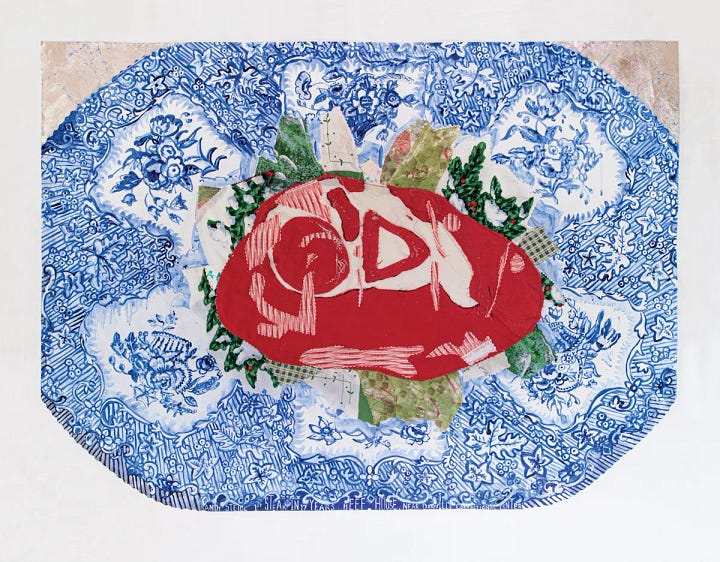

I kept in touch with Julie over the years, and I was deeply saddened to learn that she was sick with deadly ovarian cancer. When she got her diagnosis, in addition to figuring out treatments and the like, she had to figure out what to do with her Last Supper series. She had wanted to continue painting plates until the death penalty was abolished, but her diagnosis made it clear: she would not outlive the death penalty.
Rather than her 50-plate per year pace, she vowed to complete 200 more plates before her death, to bring the total number to 1000 plates. “It was very important to her to reach that volume and symbolic end point because she had intended to do it forever,” said Downes-Le Guin.
When Julie died in October of 2021, 21 years after the start of her Last Supper project, she had reached her revised goal of 1,000 plates, with each plate depicting—with great empathy and intimacy—the last meal request of a death row prisoner.
I’m happy to report that Julie’s 1000 plates have now found a permanent home; The Last Supper was gifted to the collection of the Crystal Bridges Museum of American Art, a world-class collection of American art owned by Alice Walton (of Walmart) set in Bentonville, Arkansas on 120 acres of Ozark forest with five miles of trails.
Crystal Bridges’ focus on American art makes it an ideal home for work that is so tethered to this country’s unique relationship to criminal justice and capital punishment. “It’s very fitting home for Julie’s work, given its intersection with US politics,” said Downes-Le Guin. “It’s meant to be seen and contextualized within the art of the United States.”
Crystal Bridges is also an ideal partner because their nonprofit arm, Art Bridges, is committed to expanding access to American art in all regions across the United States. “That was part of Julie’s last wishes,” said Downes-Le Guin. “She was committed to having her work shown at University museums and at second and third tier city museums that would not normally be able to access this sort of art. She wanted it to reach people who were not often reached, places where the work’s quiet but insistent questions can encourage conversations about capital punishment.”
The other piece of good news is that the First Meal book Julie started in 2020 is coming to fruition thanks to the Oregon State University Press with Julie’s coauthor, journalist Kirk Johnson. The book interweaves art and narration to tell the stories of 25 wrongfully convicted people on the day of their release. You can learn more and order at the OSU Press website. Promo code F23 garners 25% off and free shipping.
For those in Portland, you can head over to Powell’s Books on November 15, at 7:00 pm, for a talk about the artworks behind the book and how Julie came to a social and criminal justice framework for her art. Events at the Corvallis Museum and Town Hall Seattle are scheduled for December 8 and 13; Follow @upforgallery on Instagram. I’m working on getting one set up for Books are Magic as well.
Rest in peace Julie Green. I feel honored to have known you even for a short while. Thank you for bringing so much beautiful humanity to this broken world. ❤️


